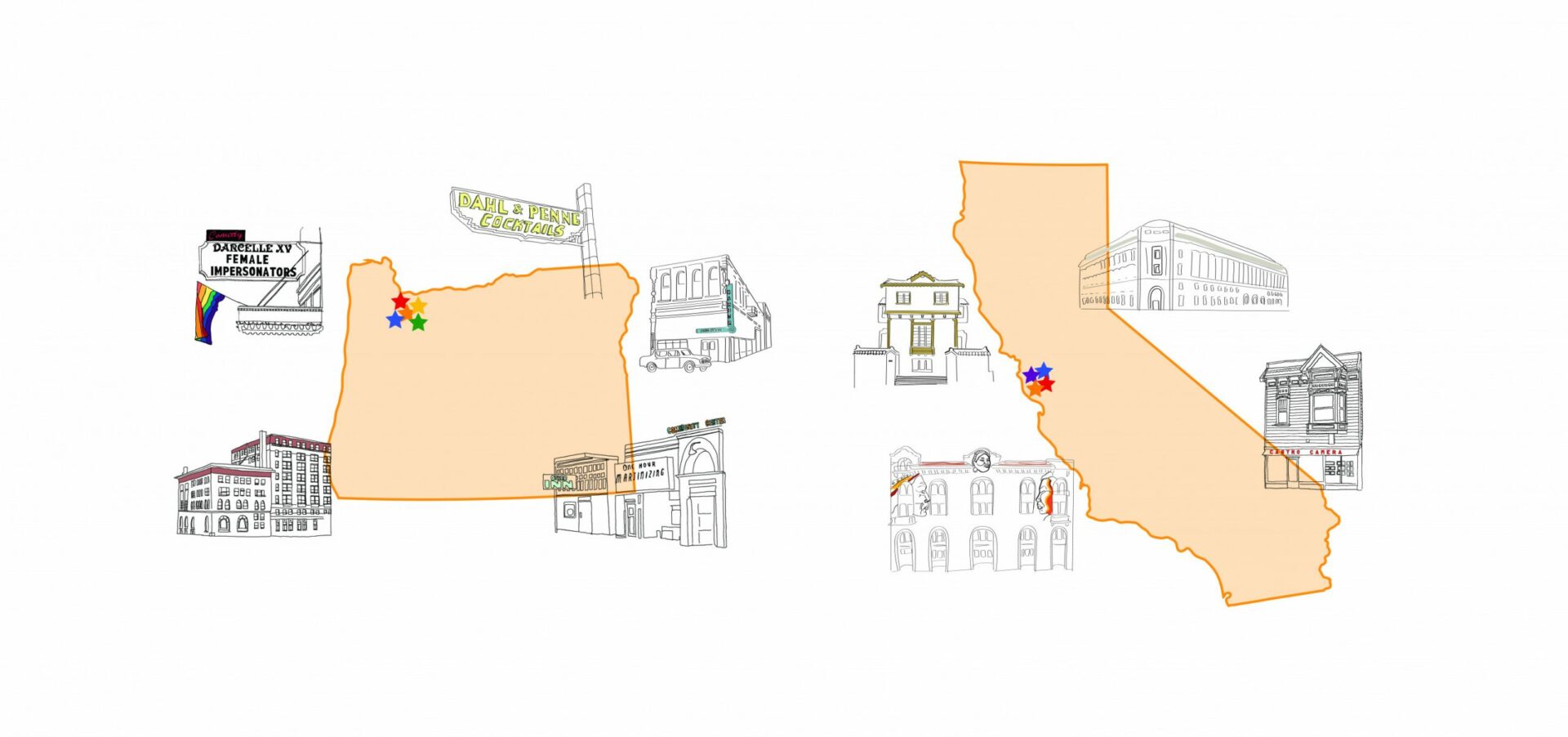
This Pride Month, MWA has been reflecting on the history of Civil Rights in the United States, considering the path we have already taken and the one we are continuing to forge. Using architecture as our lens, we have compiled historically significant buildings and places in Oregon and California that have been the backdrop for pivotal movements in LGBTQIA+ history.
Portland, Oregon

Darcelle XV Showcase
Established in 1967 by Darcelle XV — the stage name of Walter Cole — Darcelle XV Showcase has become the longest-running Drag show on the West Coast. Darcelle continued to perform here until she was 92 years old, making a stage appearance in nearly every show. In 2020, the club was added to the National Historic Registry.
Location: 208 NW 3rd Avenue, Portland, OR
For more information: Darcelle XV Showcase

The Other Inn
Deemed as Portland’s first “leather bar,” the Other Inn was run by Mama Bernice, who was beloved by her customers for taking in houseless youth in the queer community and providing them with jobs.
Former Location: 242 SW Alder, Portland, OR
For more information: The Other Inn
Gay Community Center
Located above the Other Inn, the Gay Community Center was opened in 1972 by the Second Foundation. Due to financial issues, it was closed just six months after opening and was replaced by a parking garage.
Former Location: 242 SW Alder, Portland, OR
For more information: Gay Community Center

Dahl & Penne Tavern
Located on the same block as the Community Center (above), Dahl & Penne Tavern was a popular bar and nightclub in the early 1960s that hosted drag shows. As other queer spaces closed throughout the 60s, it remained a hub for Portland’s LGBTQIA+ community. Once closed, it would be replaced by Portland’s Bank of America Tower.
Former Location: SW 2nd just off the Morrison Bridge
For more information: Dahl & Penne Tavern

The Harbor Club
The Harbor Club was one of the most popular gay and lesbian bars of the 1950s. It became notorious among local law enforcement and government officials and was targeted by Mayor Schrunk in the 1960s leading to its forced closure in 1965.
Former Location: 736 SW First Avenue, Portland, OR
For more information: The Harbor Club

YMCA
As with other YMCAs across the nation, the Portland location was known for being a space frequented by the gay community. During the 1912 “Vice Scandal” that resulted in the arrests of 68 gay men in Portland, the YMCA was targeted and raided, with 3-4 residents implicated.
Former Location: NW corner of Sixth and Taylor
For more information: YMCA Portland Vice Scandal

Multnomah Building
In 2004, Multnomah County began issuing marriage licenses to same-sex couples, resulting in thousands of marriage licenses being issued throughout the year. In April 2005, the Oregon Supreme Court nullified approximately 3,000 same-sex marriages. It wasn’t until 2014 that U.S. District Court Judge Michael McShane overturned the state’s ban on same-sex marriage.
Deanna Geiger and Janine Nelson, one of the two couples to successfully sue the State of Oregon for the right to marry, said their marriage vows in the Multnomah Building minutes after the ban was lifted.
Location: 501 SE Hawthorne Blvd
For more information: Multnomah County begins issuing marriage licenses to same-sex couples
San Francisco, California

Japanese YWCA
Established in 1932 and designed by Julia Morgan, this building housed the first Japanese American Issei (first-generation) women. It is recognized in the National Register of Historic Places for its association with civil rights and LGBTQIA+ rights groups that gathered there.
Location: 1830 Sutter Street, San Francisco, CA
For more information: Japanese YWCA

The Federal Building
The Federal Office Building was the site of an AIDS protest in 1985 when activists chained themselves to the building’s door to demand the government provide more funding for Aids research and medical services. It was recognized on the National Register of Historic Places in 2017.
Location: 50 United Nations Plaza, San Francisco, CA
For more information: The Federal Building

The Women’s Building
The Women’s Building housed the SFWC, which provided many essential social services to the community. It was a hub for activist groups fighting for more rights for the LGBTQIA+ and African American communities. The following are notable events that took place here:
- Memorial for Harvey Milk
- Pride Dance, 1981
- Lesbian Chorus, 1985
Location: 3543 18th Street, San Francisco, CA
For more information: The Women’s Building

Castro Camera
Located on Castro Street in San Francisco, the camera store was opened by Harvey Milk and became his campaign headquarters and a hub for the Gay Rights movement in the 1970s. After Milk was assassinated in 1978, it became an art gallery for the Human Rights Movement and was featured in the movie Milk.
Location: 575 Castro Street, San Francisco, CA
For more information: Castro Camera

San Francisco City Hall
San Francisco’s City Hall hosted some of the most pivotal moments for the LGBTQIA+ community. The assassination of Mayor George Moscone and Supervisor Harvey Milk occurred in City Hall in 1978.
Decades later, San Francisco City Hall hosted the first same-sex wedding in California, celebrating the marriage of Del Martin and Phyllis Lyon.
For more information: San Francisco City Hall – a Landmark
Final Thoughts
We hope that every space will welcome people regardless of sexual orientation or gender identity. Until that happens, we will continue to acknowledge the spaces that have served marginalized communities in the past and present, learning from them as we design new inclusive spaces.
Photo Credit: Sketches by MWA’s Cassidy Beckley and Madeline Jones
